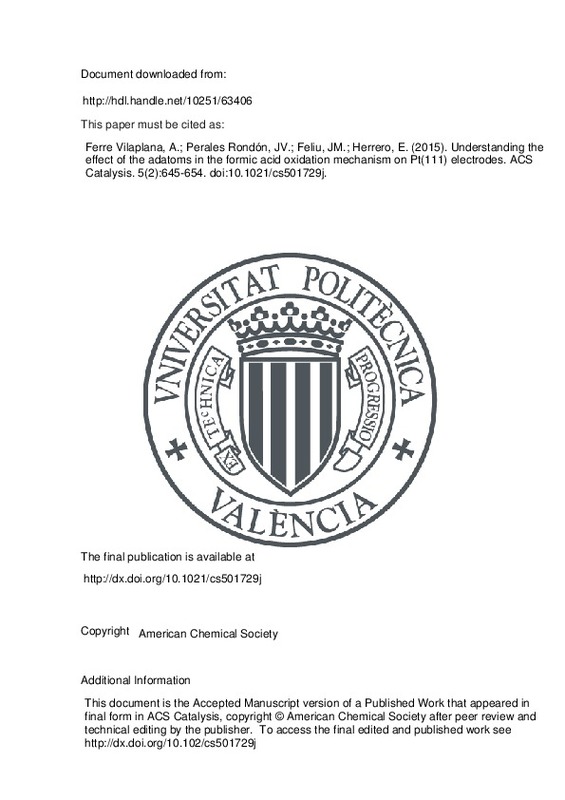JavaScript is disabled for your browser. Some features of this site may not work without it.
Buscar en RiuNet
Listar
Mi cuenta
Estadísticas
Ayuda RiuNet
Admin. UPV
Understanding the effect of the adatoms in the formic acid oxidation mechanism on Pt(111) electrodes
Mostrar el registro sencillo del ítem
Ficheros en el ítem
| dc.contributor.author | Ferre Vilaplana, Adolfo
|
es_ES |
| dc.contributor.author | Perales Rondón, Juan Víctor
|
es_ES |
| dc.contributor.author | Feliu, Juan M.
|
es_ES |
| dc.contributor.author | Herrero, Enrique
|
es_ES |
| dc.date.accessioned | 2016-05-03T10:42:53Z | |
| dc.date.issued | 2015-02 | |
| dc.identifier.issn | 2155-5435 | |
| dc.identifier.uri | http://hdl.handle.net/10251/63406 | |
| dc.description | This document is the Accepted Manuscript version of a Published Work that appeared in final form in ACS Catalysis, copyright © American Chemical Society after peer review and technical editing by the publisher. To access the final edited and published work see http://dx.doi.org/10.102/cs501729j | es_ES |
| dc.description.abstract | The engineered search for new catalysts requires a deep knowledge about reaction mechanisms. Here, with the support of a combination of computational and experimental results, the oxidation mechanism of formic acid on Pt(111) electrodes modified by adatoms of the p block is elucidated for the first time. DFT calculations reveal that some adatoms, such as Bi and Pb, have positive partial charge when they are adsorbed on the bare surface, whereas others, such as Se and S, remain virtually neutral. When the partial charge is correlated with previously reported experimental results for the formic acid oxidation reaction, it is found that the partial positive charge is directly related to the increase in catalytic activity of the modified surface. Further, it is obtained that such a positive partial charge is directly proportional to the electronegativity difference between the adatom and Pt. Thus, the electronegativity difference can be used as an effective descriptor for the expected electrocatalytic activity. This partial positive charge on the adatom drives the formic acid oxidation reaction, since it favors the formation and adsorption of formate on the adatom. Once adsorbed, the neighboring platinum atoms assist in the C-H bond cleavage. Finally, it is found that most of the steps involved in the proposed oxidation mechanism are barrierless, which implies a significant diminution of the activation barriers in comparison to that of the unmodified Pt(111) electrode. This diminution in the activation barrier has been experimentally corroborated for the Bi-Pt(111) electrode, supporting the proposed mechanism. | es_ES |
| dc.description.sponsorship | This work has been financially supported by the MINECO (Spain) (project CTQ2013-44083-P) and Generalitat Valenciana (project PROMETEOII/2014/013). | en_EN |
| dc.language | Inglés | es_ES |
| dc.publisher | American Chemical Society | es_ES |
| dc.relation.ispartof | ACS Catalysis | es_ES |
| dc.rights | Reserva de todos los derechos | es_ES |
| dc.subject | Formic acid oxidation | es_ES |
| dc.subject | Platinum | es_ES |
| dc.subject | Adatom modification | es_ES |
| dc.subject | Activation energy | es_ES |
| dc.subject | DFT | es_ES |
| dc.title | Understanding the effect of the adatoms in the formic acid oxidation mechanism on Pt(111) electrodes | es_ES |
| dc.type | Artículo | es_ES |
| dc.identifier.doi | 10.1021/cs501729j | |
| dc.relation.projectID | info:eu-repo/grantAgreement/MINECO//CTQ2013-44083-P/ES/ESTUDIOS AVANZADOS SOBRE LA REACCION DE REDUCCION DE OXIGENO/ | es_ES |
| dc.relation.projectID | info:eu-repo/grantAgreement/GVA//PROMETEOII%2F2014%2F013/ | es_ES |
| dc.rights.accessRights | Abierto | es_ES |
| dc.contributor.affiliation | Universitat Politècnica de València. Instituto Universitario Mixto Tecnológico de Informática - Institut Universitari Mixt Tecnològic d'Informàtica | es_ES |
| dc.contributor.affiliation | Universitat Politècnica de València. Departamento de Sistemas Informáticos y Computación - Departament de Sistemes Informàtics i Computació | es_ES |
| dc.description.bibliographicCitation | Ferre Vilaplana, A.; Perales Rondón, JV.; Feliu, JM.; Herrero, E. (2015). Understanding the effect of the adatoms in the formic acid oxidation mechanism on Pt(111) electrodes. ACS Catalysis. 5(2):645-654. https://doi.org/10.1021/cs501729j | es_ES |
| dc.description.accrualMethod | S | es_ES |
| dc.relation.publisherversion | http://dx.doi.org/10.1021/cs501729j | es_ES |
| dc.description.upvformatpinicio | 645 | es_ES |
| dc.description.upvformatpfin | 654 | es_ES |
| dc.type.version | info:eu-repo/semantics/publishedVersion | es_ES |
| dc.description.volume | 5 | es_ES |
| dc.description.issue | 2 | es_ES |
| dc.relation.senia | 280920 | es_ES |
| dc.contributor.funder | Ministerio de Economía y Competitividad | es_ES |
| dc.contributor.funder | Generalitat Valenciana | es_ES |







![[Cerrado]](/themes/UPV/images/candado.png)

